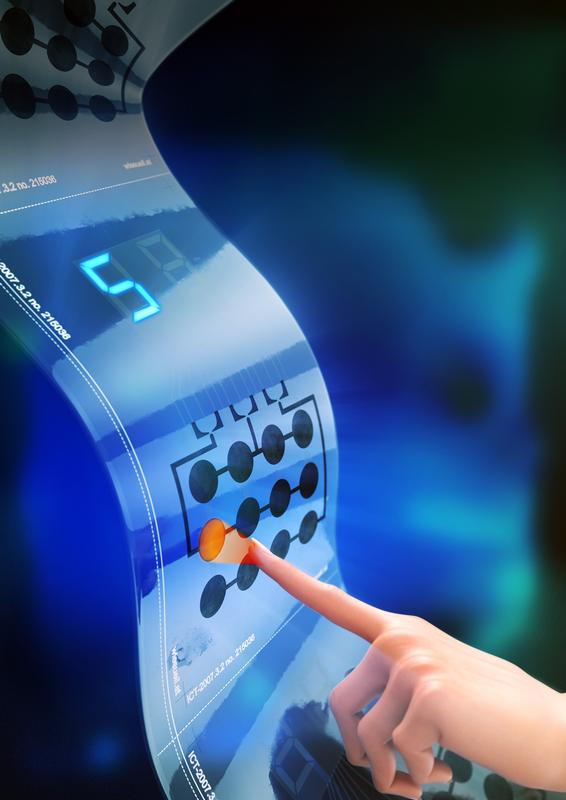Transparent – Flexible – Printable: Key technologies for tomorrow’s displays

New materials and technologies enable flexible and transparent displays. Source: Joanneum Research
Economical processing
To enable mass production in advanced display technology, manufacturing must be cost-effective and simple. This can best be achieved through more adaptable and cheaper materials but solutions for some important key details had been lacking and conventional materials tend to be expensive or not versatile enough.
The new Fraunhofer ISC sol-gel materials and inorganic-organic hybrid polymers now allow just such a simple and cost-effective processing with wet-chemical printing or roll-to-roll processes. They also advance optical, mechanical and electrical properties to open up a whole new range of applications and design options for flexible, transparent or 3D displays.
Transparent and flexible touchscreens
Up to now, there was no technology to realize flexible and transparent touchscreens with corresponding electronics. Fraunhofer ISC now presents the adequate material, already put to use within the EU-funded “Flashed!” project: printed quasi-transparent polymer piezo-sensors.
These sensors register it all: deformation, e.g. when bending a display, pressure, e.g. applied by a fingertip, and, if demanded, changes in temperature. This is why they work equally well for large curved surfaces, for turn-over displays or the on-screen operation of a flexible tablet – none of which is possible with an indium-tin-oxide-based touchscreen display.
A simple screen printing process is all it takes to apply the sensor pastes onto PET films.
The application potential of Fraunhofer ISC’s novel flexible and transparent materials does not stop here. They are also suitable to realize passivation layers and insulators in circuit boards or conductive and semi-conductive layers.
As an alternative to expensive indium tin oxide (ITO) or further metal oxide semiconductors, such as IGZO, indium-free metal oxides could be applied by dip-coating, spraying or printing in a sol-gel process.
Better light yield
Fraunhofer ISC materials are equally beneficical as intermediate layers, e.g. in OLED lighting panels. While OLEDs can be produced at low cost and are economical in use, they nevertheless suffer from scatter loss of light owing to rough interfaces between conductive and protective layers.
The scattering action could be much better controlled with a smooth, high refractive index, sol-gel based layer incorporating scatter centers. Depending on the composition, the actual light output could be significantly increased to more than 50%. Other applications for better light management in displays are feasible.
3D displays
There is much room for improvement in 3D representation and virutal reality. To advance holographic »true-to-life« 3D representations, manufacturers look to new methods and materials. Fraunhofer ISC offers novel solutions for diffractive and holographic optical elements and 3D patterning by two-photon polymerization (2PP).
Direct laser writing with two-photon absorption (TPA) – the underlying process of 2PP – enables an almost arbitrary microstructuring of surfaces and is fast, cheap and simple in comparison to conventional 3D patterning methods. In 3D displays, porous layers for liquid crystals enable switchable optical elements of variable thickness. These are suitable techniques to further optimize true 3D representations.
Media Contact
All latest news from the category: Materials Sciences
Materials management deals with the research, development, manufacturing and processing of raw and industrial materials. Key aspects here are biological and medical issues, which play an increasingly important role in this field.
innovations-report offers in-depth articles related to the development and application of materials and the structure and properties of new materials.
Newest articles

First-of-its-kind study uses remote sensing to monitor plastic debris in rivers and lakes
Remote sensing creates a cost-effective solution to monitoring plastic pollution. A first-of-its-kind study from researchers at the University of Minnesota Twin Cities shows how remote sensing can help monitor and…

Laser-based artificial neuron mimics nerve cell functions at lightning speed
With a processing speed a billion times faster than nature, chip-based laser neuron could help advance AI tasks such as pattern recognition and sequence prediction. Researchers have developed a laser-based…

Optimising the processing of plastic waste
Just one look in the yellow bin reveals a colourful jumble of different types of plastic. However, the purer and more uniform plastic waste is, the easier it is to…



